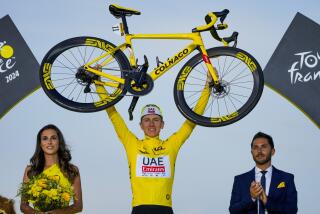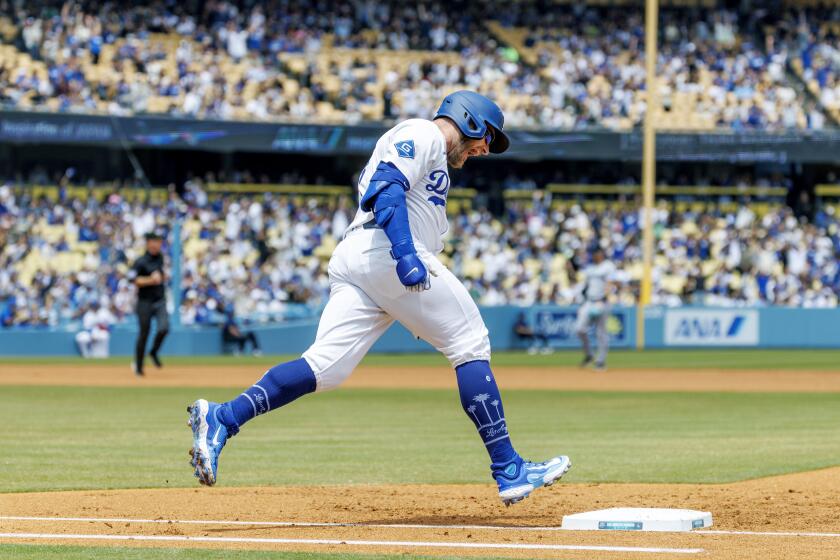TOUR DE FRANCE : Today’s Time Trial Provides First Major Test
- Share via
Greg LeMond called Dutch rival Erik Breukink the surprise of the mountain stages in last year’s Tour de France.
Although Breukink, 27, is best known as a time trial specialist, LeMond might have reserved judgment until reviewing recent cycling history. In 1988, Breukink won one of the most dramatic mountain stages in the Tour of Italy by withstanding rough elements and some of the world’s best climbers.
The stage started in a downpour, and after three hours of riding through a freezing rain, the cyclists approached the dreaded 8,600-foot Passo del Gavia. As they started climbing, the rain turned to snow. Dutch rider Joohan Van der Velde took the lead up the steep, narrow grade, with Andy Hampsten of Boulder, Colo., and Breukink trailing by a minute.
Van der Velde was first to reach the summit but then stopped, climbing into a support vehicle to get warm, although the finish was not too far down the mountain. He did not begin again for another 30 minutes.
Hampsten, known as a fierce mountain competitor, took the lead through the snow. But Breukink caught and passed him with four miles left, going on to win.
Such heroics have made Breukink part of cycling lore. But has he improved enough to challenge LeMond, a three-time Tour de France winner?
That could be answered today on a verdant, rolling stretch of Norman country road between Argentan and Alencon. This is the first true test in the three-week, 2,462-mile Tour de France as Breukink and LeMond will battle head-to-head in the race’s initial individual time trial.
The eighth stage is an all-out sprint for 45 miles that is expected to shake up the week-old standings. Unlike the long point-to-point stages in which cyclists depend on teammates to help them control the pace, the time trial is an individual endeavor.
The 194 cyclists still left in the Tour will take off one by one in reverse order of placing. The riders leave a minute apart until the top 10, when the starts are staggered by two minutes.
Although a number of outstanding time trial specialists are entered, most of the attention will be focused on Breukink and LeMond. The riders are separated by seven seconds--and one placing--after Friday’s 99.82-mile seventh stage from Le Havre to Argentan, which was won by the Netherlands’ Jean-Paul Van Poppel in 4 hours 2 minutes 18 seconds.
Breukink is fifth overall, 1 minute 14 seconds behind Tour leader Thierry Marie of France. LeMond is fourth, 1:07 behind. Djamolidine Abdoujaparov of the Soviet Union is second, 59 seconds behind Marie, and Sean Kelly of Ireland is third, 1:04 back.
As the chase begins in the afternoon, there will be a contrast of styles between Breukink and LeMond.
Breukink, who as an amateur in 1987 won every time trial he entered, is a meticulous racer. He uses a computer to monitor how fast he is going and plots each kilometer of the stage.
“Time racing needs adept talents, also concentration, motivation and mentality,” Breukink once said. “You have to want to do it.”
LeMond, on the other hand, is carefree. He does not calculate his speed or worry about wind conditions. He just rides. “My tactic is to go out from the start, all out to the finish,” he said of today’s race. “You can’t pace yourself.”
LeMond will have the advantage of chasing Breukink, a position he prefers. “I see no reason why I should hardly lose any time to Breukink, maybe even take time on him,” LeMond said.
If Breukink loses too much time, he can forget winning the Tour because LeMond is clearly the superior climber.
Still, Breukink, from Bergen aan Zee, northwest of Amsterdam, says he has shed the time trial image. “For me, the time race is just a part of the big Tour,” he said. “If you (always) win, you can become too focused on it.”
Jan Gisbers, Breukink’s PDM team director, said the Dutch cyclist has improved markedly in the last year. Breukink, who finished fourth in a team time trial at the 1984 Olympic Games, was third in last year’s Tour de France behind LeMond and Italy’s Claudio Chiappucci.
“He grew up a lot this year,” Gisbers told Sport International of the Netherlands. “He has more personality and is a better leader. He thinks that if there are other people working for him, he has to finish the job. He is there to command.”
Today’s course is typical of roads in Normandy and Brittany. “They are kind of heavy-grain, big-gravel, type roads,” LeMond said. Which means the going will be somewhat slow. At 57 kilometers, the road peaks from a gradual climb, then descends to the finish.
“It’s always up and down, they’re never perfectly flat,” LeMond said. “So it’s a very powerful time trial; you have to be in good shape.”
Breukink illustrated his ability last year when he won a time trial on the Tour’s next-to-last day. The stage, held in the rolling forest land of central France, was difficult not only because of the undulating hills, but because of the sweltering heat. LeMond finished fifth in the stage but overcame Chiappucci to win his third Tour.
LeMond said he was not too concerned with today’s results. If he wins, he said, the others will be scared of him as the race heads toward the grueling mountain stages next week.
“If I do lose time to a super Breukink, it will take a little pressure off of me,” LeMond said. “I’ll be in a position to attack.”
Unless Breukink can duplicate last year’s mountain successes.
Racing Against the Clock
A look at the type of bicycle many riders will use during Tour de France time trials. Today’s eighth stage is a 72-kilometer time trial from Argentan to Alencon in Normandy. It is the first of two individual time trials in the 23 days of racing.
HELMET: Wind tunnel tests have shown that specially designed helmets can reduce resistance and thus save valuable second. A properly built helmet can save as much time as an aerodynamic bicycle.
WHEELS: The solid wheels are called disk wheels. The front stands 26 inches, the back 27 inches. The inch difference helps put the rider into a sloping position. They often are made of solid Styrofoam with a carbon-fiber coating. The wheels absorb shock better than spoked wheels, and offer no resistance in a head wind. The back disk wheel has stickers on it that cover holes where weights are inserted to make the wheel heavier, and thus more stable. The solid wheel is not used on most other stages because of the variable wind conditions, in which spoked wheels are more efficient.
PEDALS: A quick-release toe clip, designed like a ski boot, is popular. Most riders prefer pedals with built-in play of about 10%, which reduces stress on the tendons.
FRAME: Frames, called tubes, are made of lightweight steel, aluminum, carbon fiber (often known as graphite) or titanium. Some time trial bikes have a sloping top tube, which helps the rider stay in an aerodynamic position. The bicycles usually weigh between 18 and 19 pounds.
HANDLEBARS: the clip-on bars are called aerobars, which enable the rider to tuck into a missile-like position on the bicycle by keeping his elbows as tight as possible and his back hunkered down over the front of the bike.
More to Read
Go beyond the scoreboard
Get the latest on L.A.'s teams in the daily Sports Report newsletter.
You may occasionally receive promotional content from the Los Angeles Times.










